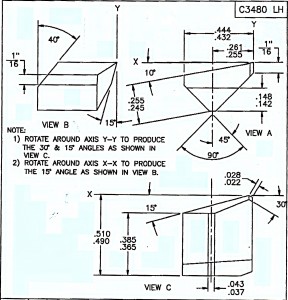How to Buy Custom Carbide Parts
This is always a little tricky. I have been doing it 30 years and I still consider it a somewhat tricky, uncertain process.
It starts with the way carbide is made. The carbon powder, tungsten powder, cobalt powder and whatever else are mixed together with wax. This wax is then pressed into shape. The pressed form is heated to melt the wax out. This leaves carbide in what is called the ‘green state’. It has a consistency softer than sidewalk chalk. This means it can be easily carved, drilled or otherwise worked to provide custom parts.
The problem comes in with the next step which is the sintering. When the parts are sintered they shrink approximately 40%. This is a fairly variable number. Calculating exactly how much the parts are going to shrink is a matter of both art and science. Unfortunately you cannot precisely calculate the amount the parts are going to shrink so tungsten carbide parts are routinely made a tad oversize. In this case figure a tad is somewhere between 0.001” and 0.003”.
As the parts were pressed into shape originally stresses were put into the part. These stresses will be relieved during heating. Additional stresses are formed during heating.
These stresses will alter the shape of the park. The project I was working on today was a long, narrow and thin part. Long, narrow and thin parts tend to move during the sintering. They may bow, twist, warp or otherwise deform.
These parts are for a customer that has been using standard bars to make tools. He now has to gear up to handle the success and he thinks that a special carbide shape could greatly speed up his production process. He is a very intelligent person and has a very good idea of what he can and cannot tolerate in the form of tolerances on the new carbide part.
The problem is that we cannot promise a part without leaving the tolerances of at least a couple thousandths of an inch.
So far I have three quotes for the customer on this part.
$ 4.40 ea.
$ 2.87 ea. with an $ 800 tooling charge
$ 8.00 ea
The tooling charge on the second quote is to make the special dies for this part. The first and third quotes do not have the tooling charge.
I have gone ahead and bought parts at the eight dollar price as I consider this far and away the best way to go.
There is more to the story, of course. The eight dollar charge is based on the quantity of 12 parts. The other charges are based on a quantity of 2000 parts. I also paid for the parts myself. It is a small amount and it was my decison to order them.
Going the way I did it we will spend a little over $100 with shipping but we will get 12 actual parts. The customer can then see how actual parts will work in his assembly process. He can then take pictures to explain what is going on. He can use a magic marker or fingernail polish to label areas on the parts that are essential and need work.
This will delay the delivery of actual production parts by about a month. It will also add a little cost to the project. However it will greatly increase the chance of getting production ready parts at the lowest cost.
Tags: About Carbide Processors, Quality
Leave a Reply




